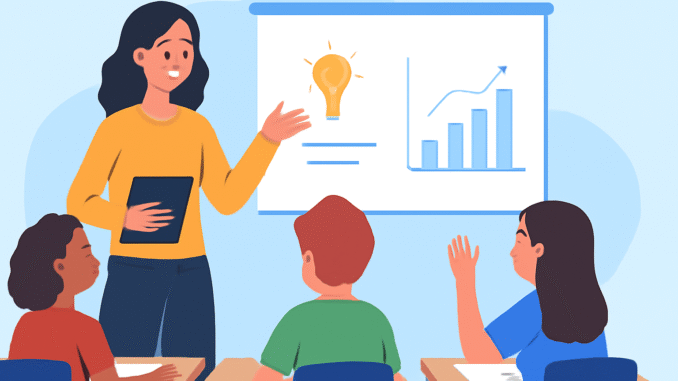
10 Innovative Teaching Strategies to Boost Student Engagement in 2025
The world of education is evolving rapidly, with new technologies, teaching methodologies, and learning environments emerging each year. As we approach 2025, it is crucial for educators to adopt innovative teaching strategies to keep students engaged, motivated, and actively participating in their learning process. The traditional methods of teaching—while effective in their own right—are no longer enough to address the needs of today’s tech-savvy and information-driven students.
In this article, we will explore 10 innovative teaching strategies that educators can implement to boost student engagement in 2025. These strategies leverage modern tools, theories, and practices to create dynamic learning environments that promote critical thinking, creativity, and collaboration.
1. Gamification: Turning Learning into a Game
Gamification is one of the most popular teaching strategies in recent years, and its effectiveness in engaging students cannot be overstated. By incorporating game-like elements—such as points, badges, leaderboards, and challenges—into lessons, teachers can make learning more fun and interactive. Gamification taps into students’ natural love for competition and rewards, which can increase motivation and participation.
For example, a teacher might create a quiz-style game for students to test their knowledge or set up challenges that encourage students to work together to solve problems. Platforms like Kahoot! and Quizizz allow teachers to design games that not only make learning more exciting but also foster a healthy competitive spirit among students.
2. Project-Based Learning (PBL): Learning by Doing
Project-based learning (PBL) is a student-centered teaching method that involves students working on real-world projects. Instead of passively receiving information, students actively engage in research, problem-solving, and collaboration to create solutions for complex issues. PBL encourages critical thinking, creativity, and teamwork—skills that are vital in today’s workforce.
In the context of 2025, PBL is increasingly being integrated with technology. For example, students might design a mobile app, develop a website, or conduct research on a global issue, using a variety of digital tools and resources. This strategy not only makes learning more relevant but also empowers students by giving them ownership of their projects.
3. Flipped Classroom: Empowering Students to Take Control
The flipped classroom is an innovative approach where students are introduced to new content at home through videos, readings, or other materials, and then use classroom time for collaborative activities, discussions, and problem-solving. This model allows students to learn at their own pace outside of class, and when they come to class, they can apply what they’ve learned in a more hands-on, interactive setting.
By flipping the classroom, educators give students more control over their learning process. The classroom becomes a space for deeper understanding, rather than passive listening. Additionally, teachers can provide more personalized feedback and support to students during class activities, increasing engagement and retention.
4. Personalized Learning: Tailoring Lessons to Individual Needs
Personalized learning focuses on tailoring the learning experience to meet the unique needs, interests, and abilities of each student. This approach can be facilitated through technology, allowing teachers to create adaptive learning pathways for each student based on their progress, strengths, and challenges.
In 2025, personalized learning will become even more effective with the use of AI-powered tools that can analyze student performance in real-time and adjust lessons accordingly. For instance, AI platforms can recommend specific activities, resources, or exercises to address a student’s learning gaps, ensuring they stay engaged and motivated throughout the course.
5. Virtual and Augmented Reality (VR/AR): Immersive Learning Experiences
Virtual and augmented reality (VR/AR) are transforming education by providing students with immersive learning experiences that were previously unimaginable. Through VR, students can explore historical sites, conduct scientific experiments, or even travel through the human body, all from the comfort of the classroom.
AR, on the other hand, overlays digital information onto the physical world, making learning more interactive. For example, students studying biology can use AR apps to examine 3D models of cells, or they might use AR during field trips to identify different plant species.
Both VR and AR offer opportunities to engage students in hands-on learning that is not possible with traditional methods, helping to improve understanding and retention of complex concepts.
6. Collaborative Learning: Building Communication and Teamwork Skills
Collaborative learning is an approach that emphasizes group work and peer-to-peer interaction. This strategy promotes active learning by allowing students to learn from one another, share ideas, and solve problems together. Collaborative activities can include group projects, peer reviews, debates, and brainstorming sessions.
In 2025, digital tools such as Google Classroom, Microsoft Teams, and Slack will make collaborative learning even more seamless. Students can work together on assignments, communicate in real-time, and share resources, all from their devices. This not only improves student engagement but also helps students develop essential teamwork and communication skills.
7. Real-World Connections: Bridging the Gap Between Classroom and Life
One of the most effective ways to engage students is by showing them how their learning connects to the real world. When students see the relevance of what they are studying, they are more likely to stay motivated and engaged. Teachers can invite guest speakers from various industries, organize field trips, or partner with local businesses to create hands-on learning experiences.
For example, a math teacher might work with a local business to show students how algebra is used in finance, or a history teacher might organize a field trip to a local museum. By connecting classroom lessons to real-world applications, teachers can make learning more meaningful and relevant for students.
8. Artificial Intelligence: Smart Learning Tools for Teachers and Students
AI is revolutionizing education by providing smart learning tools that can assist both teachers and students. In the classroom, AI can help automate administrative tasks such as grading and attendance, allowing teachers to spend more time focusing on instruction and student engagement. AI-powered tools can also provide personalized learning experiences by analyzing data on student performance and tailoring lessons accordingly.
For students, AI can provide real-time feedback on assignments, offer study recommendations, and even help with language translation, making learning more accessible. By integrating AI into the classroom, teachers can create a more efficient and engaging learning environment for their students.
9. Social-Emotional Learning (SEL): Fostering Emotional Well-being
As mental health awareness grows, educators are placing more emphasis on social-emotional learning (SEL), which focuses on developing students’ emotional intelligence, self-regulation, and interpersonal skills. SEL helps students build resilience, empathy, and self-awareness, which are essential for both academic success and personal well-being.
In 2025, SEL will be integrated into the curriculum through activities such as mindfulness exercises, conflict resolution training, and group discussions on emotional well-being. By fostering a supportive and inclusive environment, educators can help students feel more connected to their peers and more engaged in their learning.
10. Microlearning: Short, Focused Learning Sessions
Microlearning involves delivering content in small, bite-sized chunks, allowing students to learn at their own pace and on their own schedule. This strategy is particularly effective in the digital age, where students are used to consuming information quickly and in small increments. Microlearning can take the form of short videos, interactive quizzes, or even audio clips that students can access anytime, anywhere.
In 2025, microlearning will become even more prevalent, with educators using mobile apps and online platforms to deliver targeted learning materials. By breaking down lessons into smaller, more digestible pieces, teachers can help students stay engaged and focused, preventing information overload and improving retention.
Conclusion: Preparing Students for the Future
In 2025, the key to boosting student engagement lies in embracing innovative teaching strategies that leverage technology, foster collaboration, and connect learning to real-world experiences. By integrating methods like gamification, project-based learning, and personalized education, teachers can create dynamic and engaging learning environments that cater to the diverse needs of their students.
As educators, it’s important to stay adaptable and open to new teaching methods to ensure that students are not only engaged in their learning but are also equipped with the skills and knowledge they need to succeed in the future. Through these 10 innovative strategies, educators can inspire a new generation of learners who are motivated, empowered, and ready to take on the challenges of the future.

